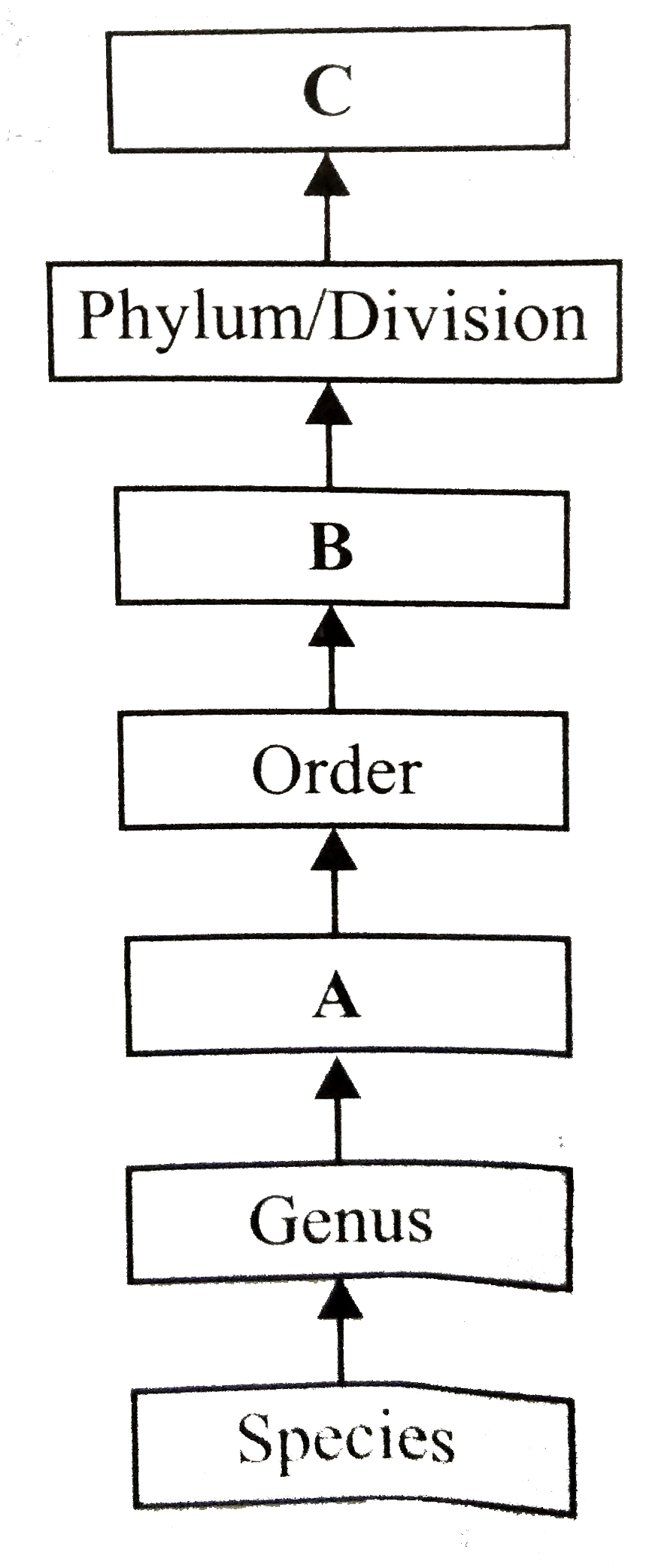As we go from species to kingdom in a taxonomic hierarchy, the number of common characteristics
will decrease
will increase
remain same
may increase or decrease.
The correct Answer is:A
To solve the question regarding the change in the number of common characteristics as we move from species to kingdom in a taxonomic hierarchy, we can follow these steps:
Step 1: Understand Taxonomic Hierarchy
The taxonomic hierarchy is a system used to classify living organisms. It consists of several levels, starting from the most specific to the most general. The levels are as follows:
- Species
- Genus
- Family
- Order
- Class
- Phylum
- Kingdom
Step 2: Analyze Characteristics at Each Level
- Species: This is the most specific level of classification. Organisms within a species share a high number of common characteristics because they are very closely related. They can interbreed and produce fertile offspring.
- Genus: As we move up to the genus level, organisms share fewer common characteristics than in species, but still have significant similarities.
- Family: At the family level, the organisms share even fewer characteristics as they may belong to different genera.
- Order, Class, Phylum, Kingdom: Continuing up the hierarchy, the number of shared characteristics decreases further. By the time we reach the kingdom level, the organisms may only share very broad characteristics.
Step 3: Conclusion
As we ascend from species to kingdom, the number of common characteristics decreases. This is because the organisms become more diverse and less similar as we group them into broader categories.
Final Answer
The number of common characteristics decreases as we go from species to kingdom in a taxonomic hierarchy.
---
The taxonomic hierarchy is a system used to classify living organisms. It consists of several levels, starting from the most specific to the most general. The levels are as follows:
- Species
- Genus
- Family
- Order
- Class
- Phylum
- Kingdom
- Species: This is the most specific level of classification. Organisms within a species share a high number of common characteristics because they are very closely related. They can interbreed and produce fertile offspring.
- Genus: As we move up to the genus level, organisms share fewer common characteristics than in species, but still have significant similarities.
- Family: At the family level, the organisms share even fewer characteristics as they may belong to different genera.
- Order, Class, Phylum, Kingdom: Continuing up the hierarchy, the number of shared characteristics decreases further. By the time we reach the kingdom level, the organisms may only share very broad characteristics.
As we ascend from species to kingdom, the number of common characteristics decreases. This is because the organisms become more diverse and less similar as we group them into broader categories.
The number of common characteristics decreases as we go from species to kingdom in a taxonomic hierarchy.
Topper's Solved these Questions
- THE LIVING WORLDBook:NCERT FINGERTPS ENGLISHChapter:THE LIVING WORLDExercise:Assertion & Reason
Explore 15 Videos
- THE LIVING WORLDBook:NCERT FINGERTPS ENGLISHChapter:THE LIVING WORLDExercise:The Living World
Explore 130 Videos
- THE LIVING WORLDBook:NCERT FINGERTPS ENGLISHChapter:THE LIVING WORLDExercise:HOTS
Explore 5 Videos
- TEST PAPERBook:NCERT FINGERTPS ENGLISHChapter:TEST PAPERExercise:Test Paper 3
Explore 50 Videos
- TRANSPORT IN PLANTSBook:NCERT FINGERTPS ENGLISHChapter:TRANSPORT IN PLANTSExercise:Transport In Plants
Explore 119 Videos
Similar Questions
In a taxonomic hierarchy, the number of common characters will increase as we go from
View SolutionRead the following statements regarding living organisms . How many of the following statements are incorrect ?
(i) As we go higher from species to kingdom, the number of common characteristics goes on increasing .
(ii) Lower the taxa more are the characteristics that the members within the taxon share.
(iii) Lower the category , greater is the difficulty of determining the relationship to other taxa at the same level.
(iv) All organisms , including those in plants and animal kingdom , have sub - species as the lowest obligate category
View Solution
Knowledge Check
The given flow chart represents the hierarchy of various taxonomic categories.
Identify the missing categories (A, Ba nd C) and select the correct statements regarding these.
(i) A is the taxonomic category which contains a number of related genera.
(ii) Example of category B are Monocotyledonae, Dicotyledonae, Mammalia, etc.
(iii) C represents the basic unit of taxonomic hierarchy.
(iv) Examples of category C are Fungi, Monera, Protista, etc.
 A(i) and (ii)B(iii) and (iv)C(i), (ii) and (iv)D(i), (ii), (iii) and (iv)
A(i) and (ii)B(iii) and (iv)C(i), (ii) and (iv)D(i), (ii), (iii) and (iv)
How many are the incorrect statements from the followings:
a) Lower the taxa, more are the characteristics that the members within the taxon share
b) Higher the taxonomic category, greater is the difficulty of determing the relationships to other taxa at the same level.
c) In lower taxa as the problems of classification becomes more complex.
d) As we go higher from species to kingdom, the number of common characters increases.
View SolutionWhich one of the following obligate category in taxonomic hierachy will have maximum number of common characters?
View SolutionIn the hierarchy of classification, which grouping will have the smallest number of organisms with maximum common characteristics and which will have the largest number of organisms?
View SolutionChoose the correct answer from the options given below:
Which of the following is a common characteristic of a covalent compound?
View SolutionAssertion: Complexity of classification increases from kingdom to species
Reason. Common characters increase from kingdom to species
View SolutionSome of the taxonomic categories in the taxonomic hierarchy are given at random. Arrange them in correct ascending series : form, class, genus, order, species, family, variety.
View SolutionFind the correct statements from the followings
(A) Each rank or taxon, in fact represent a unit of classification
(B) Every step in taxonomic hierarchy represents a rank or category
(C) A taxonomic category is a part of overall taxonomic hierarchy
(D) Taxonomic categories are not distinct biological entities, they are only biological entities, they are only morphological aggregates
View Solution

